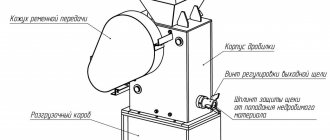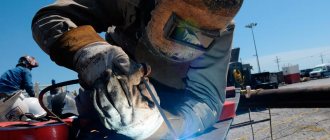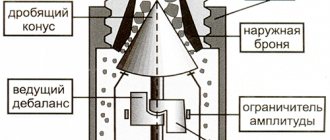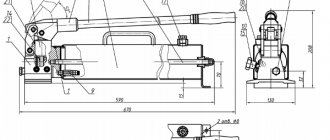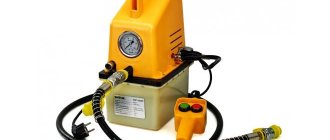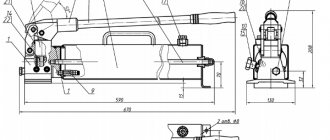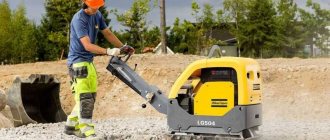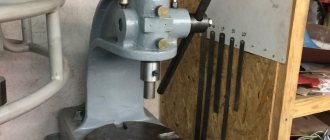Solid minerals, building materials, chemical raw materials, abrasive materials, solid secondary raw materials, and some types of plant materials are subjected to crushing. Among all types of raw materials that undergo crushing, ores of ferrous and non-ferrous metals and non-metallic minerals (coal, granites, limestones) dominate. According to a rough estimate, 2.5 - 3 billion tons of solid raw materials are crushed annually in the world.
Obviously, it is necessary to crush solid raw materials to obtain pieces of smaller size from it compared to the original material, since initially this material, for example, ore mined in a quarry, can be very large - with pieces up to 1-1.5 m in size.
Crushing operations, as a rule, are used in conjunction with the processes of classification by size (screening) of solid raw materials.
Crushing operations, like other disintegration methods, are used mainly to solve the following problems:
- To consistently reduce the size of minerals to sizes of 3-15 mm before operations of fine grinding and beneficiation of minerals.
- To obtain raw materials of the size required by direct consumers, for example, in the production of building crushed stone, abrasive materials, as well as in the preparation of solid fuels and metallurgical charge components.
- To prepare solid industrial and household waste for deep processing operations into secondary products.
- The crushing process is carried out using special machines - crushers. Material is destroyed in crushers as a result of the application of compression, shear, impact, or a combination of these forces.
Jaw crushers
One of the oldest types of crushers that are still used today are jaw crushers (JC). Crushing in them is carried out mainly due to compression forces. Design of the fire control panel; characterized by simplicity and reliability in operation. The ShchD crushing unit consists of fixed and movable plates (cheeks). The latter carries out reciprocating movements (swings) in a space that narrows downward. A slightly more complex modification of jaw crushers, compound jaw crushers (CMJC), combine reciprocating and elliptical oscillations of the jaw, which facilitates the transport of material down the crushing chamber and, in addition, ensures that combinations of compression and shear forces are applied to the crushed material, improving energy efficiency crushing process.
You might be interested in:
Corn crusher: quickly separates the grain from the cob
John Deere tractors are equipped with a “field laboratory” for applying fertilizers
New version of the Cat R2900 underground loader
Crawler bulldozer: how to choose reliable equipment
What types of tractors are there: photos, classification and types
Cone crushers
Another common type of crusher is cone crushers (CC). Crushing in a CD is carried out due to the application of compression and partial shear forces formed in a cone-shaped crushing chamber, inside which the crushing cone, suspended at its upper point, and driven by an eccentric mechanism located under the lower edge of the crushing cone, “rolls” the space .
In the mining and processing industry, over 90% of all crushers used are jaw and cone crushers. The fundamental feature of crushing in DSh and KD is their limited capabilities in terms of the degree of reduction in the size of the crushed material. Usually the degree of contraction in them does not exceed 4-5. Therefore, in traditional ore preparation schemes, three and sometimes four successive crushing stages are used.
Relatively new energy-efficient principles of crushing minerals, implementing the principles of material destruction; due to shear and partial compression forces, disintegration occurs in cone vibrating (inertial) crushers of the KID type and in high-pressure press roll crushers. In such crushers it is possible to achieve a reduction in material size by 5-10 times. Thus, it is sometimes possible to replace two crushing stages or a crushing and grinding stage with one technological operation, or to significantly reduce the average size of finely crushed material.
Mobile jaw crushers
In the production of crushed stone from hard rocks, jaw crushers have become widespread at the first stage of crushing due to the relatively large size of the loading opening and high crushing forces based on the principle of crushing. The advantages of jaw crushers also lie in their relatively small height dimensions, the ability to crush pieces of larger sizes, the ability to crush very hard rocks and ores, while the disadvantages are their relatively low productivity, high specific gravity (per unit of productivity), significant inertial loads on supporting structures, sensitivity to the humidity of the crushed material and the content of clay fractions, a large yield of flakiness and small particles.
The main crushing method of a jaw crusher is crushing due to compression of the material between the movable and stationary jaws. This is how crushers operate with a simple movement of a movable jaw suspended by the upper part on an axis. Single motion crushers are primarily designed for coarse crushing of hard and abrasive materials. Crushers with a complex jaw movement are more suitable for medium and fine crushing of materials of medium strength and abrasiveness. Complex movement, in which crushing is combined with abrasion, is more productive, but wears out armor plates faster, while the design of the crusher itself is simpler, there are fewer moving parts than in a crusher with a simple movement. However, due to their lower weight and size, crushers with complex motion are often used when crushing hard and abrasive rocks, in particular in mobile crushing and screening plants, where these advantages are crucial.
Metal costs account for about a third of all crushing costs, so the cost of the final product directly depends on the selection of armor plates. Armor plates are made of wear-resistant high-manganese steel. The working surface of the plate is made with large longitudinal and transverse corrugations. Corrugation adds a fracture to the main crushing method - crushing - which speeds up the work process. Based on the physical and mechanical properties of the rock, armor plates with different corrugations are used: corrugated, large corrugated, wide teeth, sharp teeth, plates for difficult working conditions.
Crushing chambers can be asymmetrical or symmetrical. The symmetrical crushing chamber suggests that identical armor plates can be installed on both movable and fixed cheeks, and can also be turned over. The side walls of the crushing chamber are protected by interchangeable anchor plates; a bumper plate is installed in the upper part of the movable cheek to protect the mechanisms from impacts and high pressure during the crushing process.
Mobile jaw crushers, like crushers of other types, are built on tracked chassis with an autonomous diesel engine and hydraulic drive of all actuators, less often with a diesel-electric drive. The crusher is equipped with a receiving hopper made of wear-resistant steel, a metal detector at the entrance to the crushing chamber with a function to stop the crusher, and a wide conveyor with hydraulic lifting.
Mobile jaw crushers, as a popular product, have a significant place in the production programs of suppliers of crushing and screening equipment. Sandvik Mobiles, a division of Sandvik Construction, invests heavily in research and development and is also actively acquiring successful competitors such as Extec and Fintec. Today, the Sandvik brand is represented in all categories of crushing and screening equipment, including in the jaw crushers category, the company supplies a line of 7 basic models weighing from 32 to 135 tons, including the best-selling model QJ341. Each model comes standard with features that enable it to handle everything from unique recycling to hard rock mining.
Sandvik jaw crushers are crushers with complex jaw movements. The movable cheek is suspended on an eccentric shaft driven through a flywheel and has an elliptical trajectory of movement. The spacer plate forms the connecting link between the movable jaw and the adjustment mechanism. All Sandvik jaw crushers have a deep, symmetrical crushing chamber and easy adjustment of the discharge gap. Each model has a large feed opening for its size and an ideal grip angle (16–23°), which ensures a smooth flow of material through the crushing chamber, high productivity and degree of crushing.
The line opens with the QJ241 model (previous models Extec C-10, QJ240) weighing 32.5 tons, equipped with a crusher with a loading opening of 1000x650 mm and a Cat C6.6/ C7.1 ACERT engine with a power of 168 kW.
The next models in the line are QJ331 (previous models Fintec 1107, QJ330) and QJ341 (previous models Extec C-12, QJ340) with loading openings of 1100x700 and 1200x750 mm and Cat engines with a power of 261 kW.
The middle of the line consists of the UJ440i, UJ440E and UJ540 models. The first is equipped with a Sandvik CJ412 crusher with a feed opening of 1200x800 mm, a Cat or Volvo engine with a power of 315 kW. The crusher is supplied in three versions: for crushing pure stone, pure stone with gravel, as well as stone and gravel with significant soil inclusions. The UJ440E is designed for harsh conditions. It is equipped with a CJ412 crusher with a loading opening of 1200x800 mm and a diesel generator with a power of 375 kVA. The tracked chassis and supports are driven by hydraulics, and the remaining actuators are electrically driven. The UJ440E also features a high level of automation. The high-performance UJ540 model is designed to work with the toughest rocks. The crusher with a loading opening of 1200x1100 mm is driven by a diesel generator with a power of 409 kVA.
The senior model of the Sandvik UJ640 line is equipped with the most powerful crusher CJ615 with a loading opening of 1500x1100 mm and is designed for primary crushing. The crusher is driven by a 432 kVA diesel generator, the chassis and supports are hydraulic.
Metso Mining and Construction offers a comprehensive range of mobile solutions for contracting, quarrying and surface mining, including the Lokotrack family of jaw crushers. Lokotrack's crawler-mounted Caterpillar diesel-powered units are equipped with Metso Nordberg C-Series jaw crushers. All C-Series crushers use modular frames without welded joints. This solution provides maximum fatigue strength, reliability and a variety of installation options. Nordberg crushers use a complex movement that the movable jaw receives from an eccentric shaft. Nordberg crushers also feature a long-stroke eccentric and a steep spacer plate angle, which increases the effective unloading stroke of the crusher.
The units are equipped with powerful, high-performance Metso feeders and screens, which ensures the ability to process virtually any rock or ore. The company has developed many types of armor plates for use in a variety of applications, including aggregate quarries, mines, gravel pits, and scrap and asphalt recycling. The tooth profile and armor plate thickness are optimized and combined with carefully selected manganese alloys.
Lokotrack LT Series crushers can operate close to the quarry bench, so the excavator or wheel loader operator controls the entire crushing process. This reduces work costs and workload.
For the production of aggregates, the LT series crushing plants can be used in two or three stages. For open-pit and mining applications, Nordberg's LT series crusher range is complemented by LL series conveyors and MAF (mobile apron feeder) machines.
The Lokotrack range of jaw crushers includes models LT96, LT106, LT116, LT120, LT125 and the hybrid model LT120E. The most compact model in the Metso line and one of the lightest on the market, the LT96, weighing 28 tons, is equipped with a C96 crusher with a 930x580 mm feed opening, hydraulically driven by a Caterpillar C6.6 or C7.1 engine with a power of 170 kW. The Active Setting Control system for active regulation of the discharge gap is available as additional equipment. The high-tech system regulates the width of the discharge gap and releases the crushing chamber when non-crushable material enters it.
The significantly heavier 40-tonne LT106 model is equipped with a C106 crusher with a 1060x700 mm feed opening and a 224 kW Caterpillar C9 engine. The remaining models are equipped with C13 engines with a power of 310 kW.
The next model in the line, LT116, is equipped with a crushing chamber with a loading opening of 1150x800 mm and weighs 50 tons. The LT120 model is 10 tons heavier, its loading opening dimensions are 1200x870 mm. The top model of the LT125 line is equipped with a C125 crusher with a feed opening of 1250x950 mm and weighs 86 tons.
The LT120E hybrid model can be driven from a stationary power source or from its own diesel generator. Electrical equipment increased the weight of the unit by 3 tons; in terms of operating parameters, the unit is similar to the LT120 with a diesel drive.
Terex Finlay has been designing and manufacturing mobile crushing and screening equipment for over 50 years. Since 1999, the company, with production located in Northern Ireland, has been part of the Terex Corporation. The Finlay range of jaw crushers is capable of meeting the most stringent primary crushing requirements in the construction materials industry and construction waste recycling. Today Terex Finlay offers the market five models of tracked jaw crushers: J-1480, J-1175, J-1170, J-1160 and J-1175 Dual Power.
The J-1480 is the largest and most powerful crusher in the Terex Finlay line, its transport weight exceeds 78 tons. Equipped with a 328 kW Caterpillar diesel engine, the crusher is capable of processing large pieces of material - the loading opening size is 1415x820 mm. The Finlay J-1480 is based on the Terex Jaques JW55 crusher, which can produce up to 750 t/h. Upon request, the crusher can be equipped with a direct drive, which provides fuel savings and increased efficiency, or with a standard hydrostatic drive. The hopper with a volume of 10 m3 is equipped with a system for hydraulic folding of expanders and hydraulic clamping of wedges to reduce the time it takes to deploy the machine into working position. The unit is equipped with a vibrating plate feeder.
Powered by a 261 kW Caterpillar engine, the J-1175 crusher combines a Terex Jaques JW42 crushing chamber with 1070 x 760 mm feed opening and a heavy-duty VGF vibrating grate feeder to provide optimal performance in a wide range of applications. The transport weight of the unit is 51.3 tons.
Model J-1170 differs from J-1175 in crusher parameters: the size of its loading opening is 1100x700 mm.
The most compact model in the Terex Finlay range, the J-1160 is equipped with a 224 kW Caterpillar engine, a Terex Jaques JW40 jaw crusher with a 1000x600 mm feed opening, a reinforced VGF feeder and an integrated pre-screening system.
Last fall, Terex Finlay presented a hybrid modification of the J-1175 crusher at a global dealer conference. The main drive of the J-1175 Dual Power crusher is electric from a stationary network, which allows it to achieve maximum efficiency. In case of unavailability of the power grid, an autonomous diesel generator is provided. In the Tier 2 version, the crusher is equipped with a Scania diesel engine with a power of 257 kW.
Advantages of the DualPower crusher
1. Effective in places with low electricity costs.
2. The cost of 1 ton of finished material is lower.
3. Reduced service costs.
4. The car is less susceptible to extreme conditions (frost and high altitude).
The launch of this model means that Terex Finlay has built a full range of equipment with hybrid drive - electric and diesel-electric.
The American company Kolberg-Pioneer (KPI) has been producing equipment for crushing, sorting and washing sand and crushed stone since 1928. After KPI teamed up with Johnston Crushers International Inc& (JCI) and Astec Mobile Screens (AMS), the Global Track (GT) series of mobile units, including the GT125 jaw crusher, were created and brought to market.
The GT125 model is equipped with a Vanguard Jaw 2640 crusher with a feed opening of 660x1012 mm and a capacity of up to 300 t/h. With its own weight of 38 tons, the GT125 crusher is capable of processing pieces up to 533 mm in size. The installation can be equipped with feeders of various sizes, a grate feeder, and a dust suppression system. The actuators are driven hydraulically from a 165 kW Caterpillar C7 engine.
Supply of equipment and spare parts Astec Industries, Inc. is engaged in Russia and the CIS.
Jaw crushers of the Canadian company McCloskey are built according to classical canons. The powerful modular frame is mounted on a tracked chassis, and in the working position it is additionally supported by hydraulic supports. A receiving hopper made of wear-resistant steel is installed on top of a vibration mechanism with the function of preliminary screening of “trifles,” which reduces wear on armor plates. The actuators are driven hydraulically from an autonomous diesel engine. A crusher with a complex movement of the movable jaw and reversal to free the chamber from uncrushable inclusions. The unloading gap is hydraulically adjustable. The main conveyor, if necessary, is equipped with a separator for screening out metal inclusions with a function to stop the crusher. The height of the conveyor is hydraulically adjustable; it can be easily dismantled for servicing the installation and its transportation. McCloskey equips its units with LCD diagnostic and control systems that make maintenance, troubleshooting and crusher control quick and easy.
McCloskey offers several models of jaw crushers, the markings of which begin with the letter J, that is, jaw crusher - jaw crusher. The compact J40 is indeed compact, since its weight is only 31 tons, and its transport dimensions are 13,780x2500x3200 mm, that is, when using an appropriate low-loading heavy-duty semi-trailer, the crusher can be transported on public roads without permission to transport oversized or heavy cargo.
The crusher is equipped with a Caterpillar C6.6 engine with a power of 170 kW, but its feed opening size is 1016x610 mm, that is, it can process pieces of almost half a meter.
The J44 model weighing 41 tons is equipped with a Caterpillar C9 engine with a power of 205 kW and a crusher with a loading opening of 1118x650 mm. The productive 44-ton models J45 and J45R are equipped with crushers with a loading opening of 1143x686 mm and sensors for loading the crushing chamber. The J45R model is additionally equipped with a recirculation conveyor to obtain a completely crushed and screened product.
The senior model of the McCloskey line, the J50, weighing 48 tons, is powered by a Caterpillar C9 diesel engine with a power of 261 kW. The size of the loading opening of its crusher is 1270x660 mm. An extender is added to the receiving hopper with a capacity of 6.8 m3 to increase its capacity to 10.2 m3. McCloskey products are sold in the Russian Federation by the official authorized dealer DST Market LLC.
Jaw crushers are the most widespread among mobile crushing plants. Due to their advantages - large loading opening, productivity, excellent weight and size characteristics and ease of operation - jaw crushers have found wide application in the primary crushing of non-metallic and ore materials and especially in the processing of construction scrap. With all this, a jaw crusher is not the most productive solution for the production of cube-shaped crushed stone due to the significant output of flaky and needle-like particles. For the production of cube-shaped crushed stone, impact crushers are preferable.
Hammer crushers
To crush material that is less durable than massive ore raw materials, or to crush heterogeneous material, impact crushers . The most common type of high-speed rotary crushers is hammer crushers (MD), in which the crushing elements are plate beaters (hammers) freely suspended on a horizontal shaft, made of impact-resistant steel grades. MD is used for crushing relatively soft rocks - gypsum, limestone, or for crushing various types of solid waste. Low-speed impact crushers are predominantly geared machines used to destroy, for example, fragments of reinforced concrete waste or old car tires.
Crushing solid raw materials, in particular minerals, is a very energy-intensive process. In addition, during operation, crushers require systematic replacement of worn metal linings and crushing elements.
Literature
- Perov V.A., Andreev E.E., Bilenko L.F. Crushing, grinding, screening of minerals. - M.: Nedra, 1990. - 300 p.
- Weisberg L.A., Zarogatsky L.P., Turkin V.Ya. Vibrating crushers. Fundamentals of calculation, design and technological application / Ed. L.A. Weisberg SPb.: VSEGEI. 2004. - 306 p. ISNB 93761-061-X
- Weisberg L.A., Kartavyy A.N., Korovnikov A.N. Screening surfaces of screens. - SPb.: VSEGEI. 2005. - 252 p. ISNB 5-8198-0074-5
- Fedotov K.V., Nikolskaya N.I. Design of processing plants. - M.: Mining Book, 2012. - 366 p. ISBN 978-5-98672-282-5
- Blekhman I.I. Theory of vibration processes and devices. – St. Petersburg, Publishing House “Ore and Metals”, 2013. – 640 p. ISBN 978-5-98191-074-6
- Weisberg L.A., Ustinov I.D. Industrial and laboratory equipment for the enrichment of natural and man-made raw materials // Ore enrichment, 2010, No. 5, p. 25-28. ISSN 0202-3776
Description and features of stone crushers
Crushing materials consumes about 10% of the world's energy. The data was provided by the industry resource "TBO" with reference to an article in the "Rossiyskaya Gazeta". A solid figure gives an understanding of how important stone grinding is.
The energy consumption for it largely depends on the given fraction and parameters of the raw material. There are soft, easily recyclable materials, for example, gypsum. Crushing dolomite or iron ore is much more difficult, and therefore more energy-consuming.
Energy consumption is also related to the size of the rock crushing apparatus. Mini stone crushers consume little, but produce just as much. The productivity of large-scale devices reaches 1,000 tons per hour.
The photo shows a mini stone crusher
The description of stone crushers is related to the type of their device. In addition to the one invented by Miler, there are 5 more. They have different tasks. Large enterprises, as a rule, have at least 2. The fact is that of the 6 types of crushers, not all make it possible to regulate the fraction, for example, to obtain a fine one.
It considers particles up to 25 millimeters. The diameter is from 25 to 100 average. Large fraction of more than 100 millimeters. The shape of the gravel is also important. However, more on this in the following chapters.
Types of stone crushers
The first of the necessary machines is a jaw stone crusher . It gives a large fraction. However, in any stone crusher there is a yield of several fractions. Simply, one of them is the main one. It is selected when the stone is passed through a sieve. The fraction depends on the size of its cells.
The cheek apparatus is made of two steel planes. They crush the rock. The working space between the “cheeks” of the device is wedge-shaped. In most machines, one of the crushing planes is stationary. But, there are devices with 2 active “cheeks”.
When crushing with jaws, the crushed stone is removed by moving the steel presses to the sides. Grinding occurs when the planes approach each other. They will bend some pieces of rock, grind some, and crush some.
There are 2 more crushers on the list that crush stone. These are cone and roller machines. The two shafts of the latter move towards each other. The rock is pulled into the gap between the aggregates. Their surface can be smooth or spiked.
The photo shows a jaw stone crusher
The latter option is more productive and produces a finer grind. It comes out from the bottom of the device. Consequently, “bowls” are left under the roller crushers for the crushed material. In a cone unit, the rock is pressed with a metal press.
It is shaped like a cone, hence the name of the machine. The press is lowered into a rotating “glass”, while rotating in the opposite direction. The stone is loaded into the lower container and pressed and crushed.
The conical bowls of cone crushers are stationary. This reduces the efficiency of the machines. The crushed stone is poured through a pipe into a “bowl” when the press is removed from it. A cone stone crusher is more productive and economical than a jaw or roll crusher. Small dimensions and a simpler device “speak” in favor of the latter. The more complex the circuit of the unit, the less reliable it is. Accordingly, cone crushers break down more often.
Two of the remaining types of rock crushing apparatus are impact crushers. They all have hammers. Let's start with a rotary machine. It specializes in soft or, on the contrary, materials of increased strength.
The photo shows a cone stone crusher
The devices have a 1-inch powerful rotating rotor with hammers attached to it. The rock is served on top. The simplicity of the design makes the devices reliable, and they also have high performance.
The disadvantage of impact crushers is the rapid wear of the hammers. You have to buy new ones and replace them. In addition, buying or renting a rotary stone crusher does not allow you to sift out large particles from crushed stone. The fraction turns out to be heterogeneous.
The problem of impact wear is minimized in hammer stone crushers. The industrial version is used for grinding brittle materials. Enterprises working with salt, gypsum, limestone, chalk, coal and asbestos are eager to acquire a hammer crusher. They differ from rotary machines by the hinged mounting of the impact elements.
This is what reduces their wear. In addition, hammer crushers are compact and allow you to control the grinding by adjusting the diameter of the hole for loading the stone. It remains to mention centrifugal crushers. In them, the impact mechanism is supplemented with an accelerator. The rock begins to circle around its axis. Centrifugal force works. She throws stones at the reflective plate.
Scheme of operation of a cone stone crusher
The higher the impact speed of the rock, the smaller particles it scatters. This is how the crushing fraction is regulated. Centrifugal rock grinding devices are the most economical; compared to other devices, they consume approximately 30% less energy.
Design features of modern crushers
Modern crushing equipment is equipped with a system for hydraulic or hydropneumatic regulation of the size of the discharge gap. Thanks to them, customizing the size of the final product has become much easier. In addition, the hydraulic system acts as an overload protector when crushing extremely hard materials.
In order to obtain the output fraction of the desired size, before starting use it is necessary to select the desired grinding scheme. To prevent the installation from jamming if a piece of rock that cannot be crushed suddenly gets into the chamber, the bowl is attached to the frame using a spring suspension.
Thanks to this solution, it is possible, if necessary, to enlarge the outlet opening and remove stuck solid pieces from the crushing chamber. Also now they are installing unbalanced type vibrators. They give the internal stationary cone additional vibration, which ultimately improves the quality of crushing.
Rotary
The operating principle of an impact crusher is based on the rotation of a rotor equipped with steel blades (beaters) inside a tapering annular chamber. The blades, colliding with stones, either immediately crush them or throw them onto the impact surface.
Each particle hits different surfaces multiple times at different accelerations, resulting in uniform, although not too rapid, fragmentation.
The main area of application of rotary crushers is the procurement of construction raw materials of low hardness. With their help, you can obtain a high-quality and uniform product. The main disadvantage of this design is the low durability of the beaters.
We answer questions
How much can a stone crusher cost for a summer cottage?
The cost of crushers varies widely, depending on their type and performance. A household model of the jaw or cone type will cost $200-1500.
What is the best type of stone crusher for limestone and chalk?
Rotary and roller crushers are well suited for rough grinding of these rocks; for fine grinding (production of a powder product), milling equipment can be used.
Can a jaw crusher crush granite?
Household - hardly. But jaw-type industrial equipment can easily cope with such a task.
How to repair knives on drums?
If we are talking about the beaters of rotary crushers, it is easier to replace them; if we are talking about the teeth of roller machines, you can try to align them and sharpen them using a metal file.
Is it possible to make a crusher with your own hands?
Yes, but it is not suitable for crushing stones unless you have the skills of a professional lathe, miller and welder. At home, you can make a crusher for soft lumps of substances, branches, food products - video instructions are attached.
Roller
Roller stone crushers combine pressure loads with cutting loads. The multidirectional movement of their drums, equipped with sharp teeth, pulls the primary material inside, where it is subjected to strong compression and axial abrasion, as well as multiple impacts on the cutting edges.
Due to their low cost, open design, ease of maintenance and repair, roller crushers are very popular in small industries. They are quite effective and provide high product homogeneity, but are prone to rapid wear.
In some cases, the area of the teeth is increased, and their edges are not sharpened. This reduces the productivity of the crusher, but increases its resource and makes it possible to work with more durable rocks and substances.
Do-it-yourself stone crusher: all the pros and cons
Homemade crushers are usually jaw crushers. They are easier to make than others. A sheet of cast iron is used as a fixed plane. It is installed at an angle on the base. The latter must be firmly fixed. This will make it possible to change the angle of inclination, and at the same time the gap for crushing.
The second cheek of homemade crushers is a wide metal shaft. It rotates in the direction of filling the stone through a belt drive by an electric motor. Without gear, the motor may jam. In addition, the belt hitch reduces the number of revolutions.
By shifting the lower attachment point of the fixed cheek in the longitudinal plane, you can adjust the crushing parameters. However, flat and sharp-angled screening will be 80% versus 50% in factory settings.
The photo shows a do-it-yourself stone crusher
The structure will wear out quickly. Of course, there is no warranty service. This is a minus of homemade crushers. However, they are suitable for subsidiary farming. However, you can purchase a portable crusher.
This new product on the market is inferior in performance to stationary ones, but it is economical, accessible, and does not require special equipment for dismantling and transportation. At the same time, a factory warranty and the availability of replacement units are guaranteed.
What to look for when choosing a crusher
- Diameter of the crushing chamber, diameter of the inlet and outlet holes, maximum size of the initial product
- Technical specifications. To prepare the installation site, you must know such characteristics as length, width, height, and total weight.
- Productive capacity. The performance of the installation depends on this.
- Volumes of the finished product. They will depend on: the shape of the chamber and the width of the loading slot;
- raw material supply speed;
- rock hardness recommended for processing;
- size of pieces of loaded rock.
Choosing a device for home and professional use
When choosing a specific stone crusher model, it is important to know not only the required productivity and the nuances of the granulometry of the equipment, but also to navigate the physical properties of the materials with which you will have to work.
First of all, we are talking about hardness and abrasiveness indicators. Knowing these properties, as well as the budget for purchasing equipment, you can decide on the required type of working parts.
Then they start choosing the chassis. If the stone crusher will be installed directly at the site of production of finished goods or semi-finished products from lump raw materials, it is better to give preference to stationary models; in all other cases, it is worth purchasing towed crushers. The use of self-propelled devices is justified only in the mining industry, when the hourly productivity of work is estimated at tens of tons.
Historical reference
Since ancient times, crushing stones and other hard materials was done manually - first, large blocks were split with picks, then smaller ones were crushed with a hammer tool. The first attempts to mechanize the process date back to the late Middle Ages. They are piles covered with metal, suspended on cables and driven by the force of the river current.
With the advent of the era of steam engines, the first full-fledged stone crushers appeared, similar in principle to modern ones. In them, metal platforms, rolls or other working elements exerted pressure on the material until it crumbled into pieces.
Application area
The scope of application of the equipment involves working with different materials. The jaw crusher is most often used specifically for crushing stone, as well as crushed stone, which will allow obtaining the material of the required fraction. In construction, the unit has found application for grinding various materials, such as brick, limestone, which must be subsequently used for preparing the foundation, laying road surfaces and a number of other products.
A current solution would be to use such equipment for grinding coal and old concrete, which can be reused in the future. Recently, the equipment has been actively used when it is necessary to crush glass. Glass can be crushed to the smallest fraction, which will allow this material to be reused to obtain the required consistency.
A few words about the shortcomings
No production machine is perfect, and jaw crushers are no exception. Disadvantages include:
- vibration of buildings during operation of the installation (therefore crushers are placed only on the lower floors);
- the need to manually load workpieces to avoid clogging the working area;
- interruptions in operation due to foreign bodies entering the crusher (for example, metal).
However, the disadvantages pale in comparison to the advantages of jaw crushers. Therefore, the equipment is still in demand when processing minerals, and it is quite difficult to find analogues.
